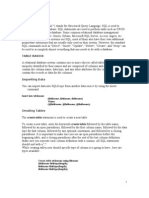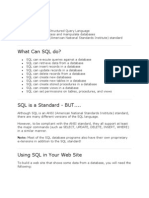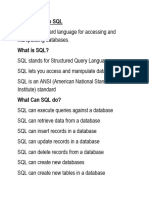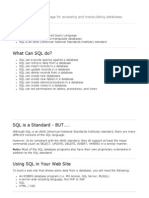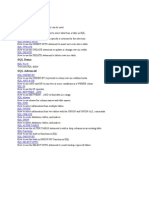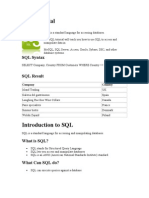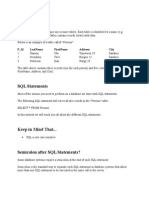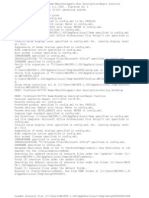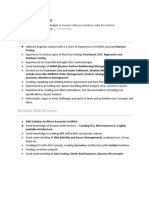SQL (Structured Query Language)
Uploaded by
Chemutai JoyceSQL (Structured Query Language)
Uploaded by
Chemutai JoyceSQL (Structured Query Language)
SQL is a language designed to work with relational databases In the mid 1970s, SQL was developed under the name SEQUEL (for Structured English Query Language?) at the IBM San Jose research facilities to be the data manipulation language for IBM's prototype relational model DBMS called "System R". In 1980, the language was renamed SQL to avoid confusion with an unrelated hardware product called SEQUEL. SQL is currently used (and has been for quite some time) as the data manipulation language for most relational database management products on the market today. This includes IBM's DB2, Oracle, XBase (dBase, FoxPro, etc.), MS SQL Server, and Access.
Mwangi H. 1
Tuesday, June 05, 2007
SQL
On its own, SQL is a "non-procedural" language, meaning a program is not typically written in "straight SQL". SQL accomplishes many powerful tasks with a mere seven statements: SELECT, UPDATE, INSERT, DELETE, CREATE, ALTER, and DROP. Each of these seven statements fall into one of two categories: DML (Data Manipulation Language) statements or DDL (Data Definition Language) statements. These statements are summarized as follows:
Mwangi H. 2
Tuesday, June 05, 2007
DML Statements
SELECT Enables you to select one or more columns from one or more tables in the database. The results can be simply viewed, or can be used as the basis for a form or report, or, in the case of embedded SQL, can be processed as a temporary table (called a "recordset" in Access, called a "cursor" in other DBMSs).
UPDATE Enables you to update the data in one or more columns of one or more rows in a table.
INSERT Enables you to append rows to an existing table.
DELETE Enables you to delete one or more rows from an existing table.
Mwangi H. 3
Tuesday, June 05, 2007
DDL Statements
CREATE Enables you to create a new table, or to create a new index on an existing table.
ALTER Enables you to modify the structure of an existing table (by adding or deleting columns). DROP Enables you to delete a table
Tuesday, June 05, 2007
Mwangi H.
Example
Tuesday, June 05, 2007
Mwangi H.
The Basic SELECT Query
The SELECT query retrieves one or more columns (fields) from a table. The basic syntax is:
SELECT field1 [, field2, ... fieldn] FROM tablename Notes: If more than one field is specified, each field must be separated with a comma. If you want to select ALL fields from a table, you can use an asterisk (*) instead of a list of all the fields.
Mwangi H. 6
Tuesday, June 05, 2007
Example 1:
Retrieve all columns and all rows from the Employees table.
SELECT * FROM EMPLOPYEES
Tuesday, June 05, 2007
Mwangi H.
Example 2:
Retrieve the Product ID, product name, and unit price from all rows of the Products table: SELECT ProductID, ProductName, UnitPrice FROM Products
Tuesday, June 05, 2007
Mwangi H.
Adding a WHERE Clause
By adding an appropriate WHERE clause to a SELECT statement, you can limit the number of rows (records) returned by the query. The WHERE clause specifies a condition that must be met in order for that row be returned.
Note: In the WHERE clause, numeric literals have no delimiters, string literals are delimited by single quotes (') (although Access will also accept double quotes(")), and date delimiters are delimited by the number sign (#). Delimiting dates with the number sign is specific to Access; most other DBMS' use the single quote as the date delimiter.
Mwangi H. 9
Tuesday, June 05, 2007
Example 3:
What is the name for product ID 19?
SELECT ProductName FROM Products WHERE ProductID = 19
Tuesday, June 05, 2007
Mwangi H.
10
Example 4:
Which customers are from Mexico? (Show Customer ID, company name, contact name, and contact title in the results.) SELECT CustomerID, CompanyName, ContactName, ContactTitle FROM Customers WHERE Country = 'Mexico'
Tuesday, June 05, 2007
Mwangi H.
11
Example 5:
Which employees were hired on October 17, 1993? (Show employee first and last name, and title in the results.)
SELECT FirstName, LastName, Title FROM Employees WHERE HireDate = #10/17/1993#
Tuesday, June 05, 2007
Mwangi H.
12
Compound Conditions (Using AND and OR) EX 6
Which meat/poultry products (CategoryID = 6) have less than 10 units in stock? (Show product ID, product name, category ID, and units in stock in the results.)
SELECT ProductID, ProductName,CategoryID, UnitsInStock FROM Products WHERE CategoryID = 6 AND UnitsInStock < 10
Mwangi H. 13
Tuesday, June 05, 2007
Example 7:
Which items in the Product table are classified as meat/poultry or have less than 10 units in stock? (Show product ID, product name, category ID, and units in stock in the results.)
SELECT ProductID, ProductName, CategoryID, UnitsInStock FROM Products WHERE CategoryID = 6 OR UnitsInStock < 10
Tuesday, June 05, 2007
Mwangi H.
14
Example 8:
Show the product name, units in stock, category ID, and unit price for seafood products (category ID = 8) that have at least 100 units in stock, or for any item whose unit price is greater than $50.
SELECT ProductName, UnitsInStock, CategoryID, UnitPrice FROM Products WHERE UnitsInStock >= 100 AND CategoryID = 8 OR UnitPrice > 50
Mwangi H. 15
Tuesday, June 05, 2007
Example 9:
Show the part product name, units in stock, category ID, and unit price for products that have at least 100 units in stock, and that are either classified as seafood (category ID = 8) or have a unit price greater than $50.
SELECT ProductName, UnitsInStock, CategoryID, UnitPrice FROM Products WHERE UnitsInStock >= 100 AND (CategoryID = 8 OR UnitPrice > 50)
Mwangi H. 16
Tuesday, June 05, 2007
Example 10:
Show the company name, contact name, and country for all non-US suppliers.
SELECT CompanyName, ContactName,Country FROM Suppliers WHERE NOT (Country = 'USA')
Tuesday, June 05, 2007
Mwangi H.
17
Using BETWEEN / AND
Show the Product ID, product name, and unit price for all products that have a unit price between $10 and $15 (inclusive):
SELECT ProductID, ProductName,UnitPrice FROM Products WHERE UnitPrice BETWEEN 10 AND 15 This query could also be coded as:
SELECT ProductID, ProductName, UnitPrice FROM Products WHERE UnitPrice >= 10 AND UnitPrice <= 15
Tuesday, June 05, 2007 Mwangi H. 18
Example 12:
Show the Order ID, Customer ID, and order date for orders that occurred between February 1 and February 7, 1995.
SELECT OrderID, CustomerID, OrderDate FROM Orders WHERE OrderDate BETWEEN #2/1/1995# AND #2/7/1995#
Tuesday, June 05, 2007
Mwangi H.
19
Reminder:
In Access SQL, Date literals must be delimited by pound signs (#). In most other database systems, dates are delimited with single quotes (same as strings). Also: Queries based on dates become slighltly more involved if the dates have a time component to them (the dates in this database do not have a time component, but they could, because Date/Time fields can store both date and time together). If the OrderDate field contained a time component, you would have to write the WHERE clause of the above query like this:
WHERE OrderDate BETWEEN #2/1/1995# AND #2/7/1995 11:59:59PM# - or WHERE OrderDate >= #2/1/1995# AND OrderDate < #2/8/1995#
Tuesday, June 05, 2007 Mwangi H. 20
Using Computed Columns (Expressions) Example 13:
Show the OrderID, ProductID, UnitPrice, Quantity, Discount, and line item total for order line items that total at least $300. SELECT OrderID, ProductID, UnitPrice, Quantity, Discount, (UnitPrice * Quantity * (1 - Discount)) as TotalPrice FROM [Order Details] WHERE (UnitPrice * Quantity * (1 Discount)) >= 300
Mwangi H. 21
Tuesday, June 05, 2007
Result of the above query
Tuesday, June 05, 2007
Mwangi H.
22
Using LIKE Example 15:
Show company name, contact name, and title for customers whose contact person is considered a "manager".
SELECT CompanyName, ContactName, ContactTitle FROM Customers WHERE ContactTitle LIKE %Manager%'
Tuesday, June 05, 2007
Mwangi H.
23
Result of the above query
Tuesday, June 05, 2007
Mwangi H.
24
Using IN Example 16:
Show company name and address information for all suppliers located in France, Germany, and Italy.
SELECT CompanyName, Address, City, Country, PostalCode FROM Suppliers WHERE Country IN ('France', 'Germany', 'Italy')
Mwangi H. 25
Tuesday, June 05, 2007
Result of the above query
Tuesday, June 05, 2007
Mwangi H.
26
or
This query could also be coded as:
SELECT CompanyName, Address, City, Country, PostalCode FROM Suppliers WHERE Country = 'France' OR Country = 'Germany' OR Country = 'Italy'
Tuesday, June 05, 2007
Mwangi H.
27
Sorting with the ORDER BY clause
Show the category ID, unit price, and product name for all products, sorted by unit price (low to high).
SELECT CategoryID, UnitPrice, ProductName FROM Products ORDER BY UnitPrice
Tuesday, June 05, 2007
Mwangi H.
28
Result of the above query
Tuesday, June 05, 2007
Mwangi H.
29
Example 17
Show the category ID, unit price, and product name for all products, sorted by unit price (high to low).
SELECT CategoryID, UnitPrice, ProductName FROM Products ORDER BY UnitPrice DESC
Tuesday, June 05, 2007
Mwangi H.
30
The COUNT Function
The COUNT function in a SELECT statement returns a count of the number of records in a table (if the statement has a WHERE clause, it returns only the number of records that meet the specified condition).
How many products are classified as beverages (category ID 1)? SELECT COUNT(*) AS BeverageCount FROM Products WHERE CategoryID = 1
Mwangi H. 31
Tuesday, June 05, 2007
The SUM Function
The SUM function in a SELECT statement returns the sum of a numeric field or expression for all of records in a table (if the statement has a WHERE clause, it sums that field only for the records that meet the specified condition).
How many order lines do we have, and what is their total value? SELECT COUNT(*) AS OrderLineCount, SUM(UnitPrice * Quantity * (1 + Discount)) AS OrderLineTotal FROM [Order Details]
Tuesday, June 05, 2007
Mwangi H.
32
Using DISTINCT
Use the DISTINCT keyword to show each customer in the ORDERS table only once
SELECT DISTINCT CustomerID FROM Orders
Tuesday, June 05, 2007
Mwangi H.
33
Grouping Data with the GROUP BY Clause
When you group data, you create a query that produces one record for each unique value of a field (or combination of fields) in a table (limited by the WHERE clause, if there is one). Any of the SQL functions discussed earlier (COUNT, SUM, AVG, etc.) apply to the grouped record.
Show the order ID and order total for each order. SELECT OrderID, SUM(UnitPrice * Quantity * (1 + Discount)) AS OrderTotal FROM [Order Details] GROUP BY OrderID
Tuesday, June 05, 2007
Mwangi H.
34
Tuesday, June 05, 2007
Mwangi H.
35
You might also like
- NI TestStand 2 Framework Development Course Manual (National Instruments60% (5)NI TestStand 2 Framework Development Course Manual (National Instruments142 pages
- Test Bank Database Systems Design Implementation and Management 11th Edition100% (2)Test Bank Database Systems Design Implementation and Management 11th Edition13 pages
- Department of Computing: CS-220: Database Systems Class: BSCS-4C100% (1)Department of Computing: CS-220: Database Systems Class: BSCS-4C14 pages
- What Is SQL?: Insert Into Tablename (Fieldname, Fieldname, Fieldname) Values (@fieldname, @fieldname, @fieldname)No ratings yetWhat Is SQL?: Insert Into Tablename (Fieldname, Fieldname, Fieldname) Values (@fieldname, @fieldname, @fieldname)20 pages
- ST, Marry University Faculty of Informatics Department of Computer ScienceNo ratings yetST, Marry University Faculty of Informatics Department of Computer Science42 pages
- Writing SQL Queries - Let's Start With The BasicsNo ratings yetWriting SQL Queries - Let's Start With The Basics6 pages
- SQL Is A Standard Language For Accessing and Manipulating Databases100% (1)SQL Is A Standard Language For Accessing and Manipulating Databases190 pages
- What Is SQL?: SQL Is A Standard Language For Accessing and Manipulating DatabasesNo ratings yetWhat Is SQL?: SQL Is A Standard Language For Accessing and Manipulating Databases102 pages
- Basic SQL Commands: (Structured Query Language)100% (4)Basic SQL Commands: (Structured Query Language)20 pages
- SQL Basic: SQL Introduction SQL Select SQL Where SQL Insert Into SQL Update SQL DeleteNo ratings yetSQL Basic: SQL Introduction SQL Select SQL Where SQL Insert Into SQL Update SQL Delete23 pages
- Unit 1 Overview of Basic SQL StatementsNo ratings yetUnit 1 Overview of Basic SQL Statements30 pages
- Introduction To Access SQL: SELECT StatementsNo ratings yetIntroduction To Access SQL: SELECT Statements5 pages
- Database Tables: P - Id Lastname Firstname Address CityNo ratings yetDatabase Tables: P - Id Lastname Firstname Address City19 pages
- DB2 11.1 for LUW: SQL Basic Training for Application DevelopersFrom EverandDB2 11.1 for LUW: SQL Basic Training for Application DevelopersNo ratings yet
- Microsoft Office Professional Plus Setup (20121017103554D50)No ratings yetMicrosoft Office Professional Plus Setup (20121017103554D50)48 pages
- "Hosting A Static Gym Website Using AWS S3 Service": A Project Report ONNo ratings yet"Hosting A Static Gym Website Using AWS S3 Service": A Project Report ON15 pages










